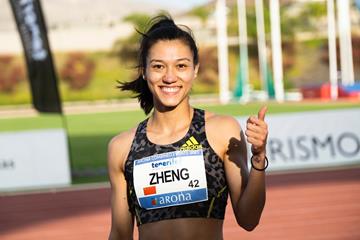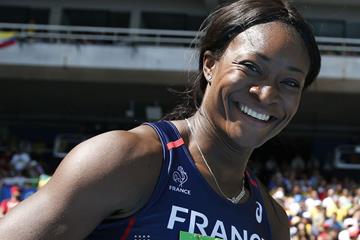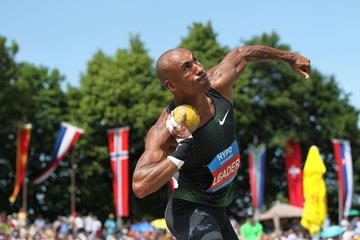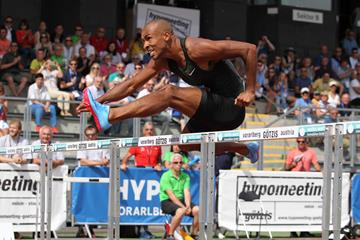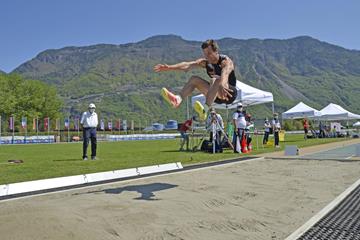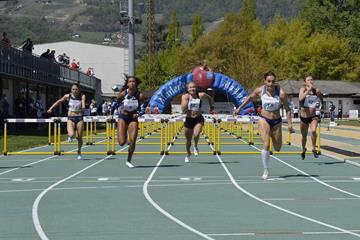 Countdown
Countdown
 Countdown
Countdown
The heptathlon is a combined track and field event that consists of seven disciplines across a two-day period. Competitors earn points for their performance in each discipline and the overall winner is the athlete who scores the most points. It’s considered to be the ultimate all-round-test for female athletes.
Women first competed in the pentathlon, a five-discipline event, at the 1964 Olympics in Tokyo
The pentathlon originated in Ancient Greece, where it consisted of the long jump, javelin throw, discus throw, stadion (foot race) and wrestling
The heptathlon replaced the pentathlon and made its Olympic debut at the 1984 Games in Los Angeles
The events of the heptathlon are: 100 metres hurdles, high jump, shot put, 200 metres, long jump, javelin throw and 800 metres
The men’s equivalent is the decathlon, though men contest a heptathlon indoors.
Great Britain, USA and Germany have a strong legacy in the heptathlon, with multiple world and Olympic titles won over the years.
The first IAAF-ratified record in the women’s heptathlon belongs to Jane Frederick (United States), who scored 6104 points in 1981. However, she was not the first athlete to cement her place at the top of the heptathlon points table. This honour went to Liesl Albert (Germany), whose 5654 points constituted the first unofficial record in 1978.
Women’s heptathlon standings progressed rapidly over the next decade. The two most prolific record-setters were Ramona Neubert (East Germany) and Jackie Joyner-Kersee (United States). Both heptathletes produced four successive records.
Neubert’s began with 6670 points in 1981 and culminated in a 6935-point effort in 1983. Three years later, Joyner-Kersee earned her place at the top of the heptathlon points table. She scored 7148 points, a feat that made her the first heptathlete to cross the 7000-point threshold. Her fourth world record of 7291 points, achieved in 1988, is still the highest heptathlon score of all time.
Today, Joyner-Kersee's record remains unbeaten.
Note: Each of the records here has been adjusted to reflect the points tables that are currently in use. For example, Jane Frederick’s original score was 6166 points. However, her comparative score today would be 6104 points.
In addition to her world records, Jackie Joyner-Kersee is among the greatest Olympic heptathletes in history. The US all-rounder secured back-to-back titles at the 1988 and 1992 Games, as well as two World Championship titles in 1987 and 1993. Only one other female heptathlete has replicated her success: Nafi Thiam. The Belgian powerhouse won Olympic gold in 2016 and 2021, as well as world titles in 2017 and 2022.
Three British heptathletes (Denise Lewis, Jessica Ennis-Hill and Katarina Johnson-Thompson) have secured a combined total of two Olympic wins and five world titles in the heptathlon.
Lewis was the first British heptathlete to take gold at the Olympics (2000). Ennis-Hill is Britain’s most accomplished heptathlon competitor ever with three world titles (2009, 2011, 2015) and one Olympic win (2012). Meanwhile, Johnson-Thompson became a two-time world champion in 2023, having won her first title in 2019.
More recently, Anna Hall (United States) has risen through the heptathlon ranks, claiming world bronze in 2022 and world silver in 2023.
Ghada Shouaa achieved a historic win at the 1996 Olympic Games, becoming the first Syrian sportsperson to claim a gold medal.
Heptathlon performers are often world class in individual events, as well as being good all-round athletes. This was displayed at the 2016 Olympics by Nafi Thiam of Belgium. On her way to heptathlon gold, she produced a world-class high jump of 1.98m. This would have been good enough to win the gold in the individual women’s high jump.
The seven events in the heptathlon are structured across two days. Here is the order of heptathlon events:
Day one: 100m hurdles, high jump, shot put and 200m
Day two: long jump, javelin throw and 800m
100m hurdles: The 100 metres hurdles opens the heptathlon. This event sees athletes sprint over ten hurdles, set at 8.5 metres apart, along a 100-metre track.
High jump: This event involves the athlete jumping unaided over a high horizontal bar. Competitors aim to clear the highest height without dislodging the bar.
Shot put: In the shot put, athletes put a heavy ball (the shot) as far as possible. For female athletes in the heptathlon, the shot weighs 4kg (8.8lb).
200m: The first day culminates in the 200 metres. This is a half-lap race that begins on the final bend and ends with a straight sprint towards the finish line.
Long jump: The second day starts with the long jump. This event sees athletes sprint down a runway and leap into a sandpit. The aim is to secure the maximum distance between the take-off line and the first indent in the sand.
Javelin: In the javelin, competitors throw a spear-like implement (the javelin) as far as possible.
800m: The final event of the heptathlon is the 800 metres. Often called the two-lap sprint, this distance requires athletes to complete two laps of the track as quickly as possible.
The heptathlon scoring system uses points tables in each event. Athletes earn points for their performance in each discipline and the winner is the competitor who scores the most points overall. As such, poor performance in one event can significantly impact a competitor’s overall score.
Each event has a minimum recordable performance level. However, these benchmarks differ across the seven heptathlon events.
The times, heights and distances achieved are translated into points using a heptathlon score calculator. To score 1,000 heptathlon points in each discipline, an athlete would have to produce the following results:
100m hurdles: 13.85 seconds
High jump: 1.82m
Shot put: 17.07m
200m: 23.80 seconds
Long jump: 6.48m
Javelin throw: 57.18m
800m: 2:07:63 minutes
T The physically demanding nature of the heptathlon means that the event demands a wide range of techniques. Athletes must possess endurance, explosive strength, mobility, agility and exceptional running skills.
Here are the core components and techniques required for heptathlons:
Sprinting: Runners must produce fast acceleration and maintain top speeds
Hurdling: Athletes need to maintain rhythm over hurdles and consistent sprinting patterns between hurdles
Jumping: The high jump and long jump demand incredible power, explosivity and impeccable technique
Throwing: Strength, accuracy and balance are key components in the shot put and javelin
A quick start and smooth acceleration are critical, particularly in the 100m hurdles and the 200m sprint. Athletes must be able to reach and maintain top speed while also conserving the energy required for subsequent events.
The heptathlon finishes with the 800m. This final event covers two laps of the track and tests the athlete’s running abilities, stamina and their pacing technique.
Proper hurdling technique involves a quick, rhythmic approach. This includes maintaining a close distance to the hurdle in order to prevent loss of speed. Athletes must be able to sprint between hurdles in three to four steps.
The high jump and the long jump require short bursts of explosive power. In the high jump, the approaching angle and take-off technique are crucial to success. Meanwhile the long jump demands a careful blend of speed, timing and explosive power.
The shot put and javelin rely on a combination of strength, controlled rotation and precise putting/throwing techniques. The athlete must maintain a proper grip and stance throughout the motion. Additionally, release angles are vital to maximise putting/throwing distance.
The heptathlon rules incorporate the guidelines and techniques of each individual discipline. Additionally, this combined event is also governed by its own set of rules. These include:
The result in each event is converted into points
Points are awarded for the distance, height or time achieved in each event and recorded in the heptathlon points table
The total number of points an athlete achieves from all seven events determines their final standing
To qualify for ranking, competitors must start or make a trial in all seven heptathlon events
The events must be contested in the prescribed order over two consecutive 24-hour periods
Failure to attempt to start or make a trial in an event will result in elimination
Athletes must comply with the rules of each discipline, though some of them are slightly adjusted
Heptathletes are allowed to commit one false start per race in the track events. A second false start, independently of who was responsible for the first false start, leads to disqualification
Competitors are permitted three attempts in the long jump, shot put and javelin throw
Should athletes end the competition with the same number of points, it is determined as a tie
Common fouls in the heptathlon include:
Running events: false starts, lane infringements and obstructing other competitors
Jumping events: Knocking down the bar in high jump or stepping beyond the take-off line in the long jump
Throwing events: Stepping out of the shot put circle or on or beyond the throwing arc in the javelin, improper release of the implement or the implement landing on or outside the landing sector
The difference between the decathlon and the heptathlon is the number of disciplines. Heptathlon, derived from the Greek word ‘hepta’ (seven), includes seven events; decathlon, which comes from the Greek word ‘deka’ (ten), includes 10 events. Outdoors, the heptathlon is for women while the decathlon is normally contested by men.
Not to be confused with the ‘modern pentathlon’, the pentathlon in athletics is a five-event competition that preceded the heptathlon. Taking its name from the Greek word for five, women first competed in the pentathlon at the 1964 Olympic Games.
Moreover, indoors, women compete in a pentathlon consisting of the following five events: 60 metres hurdles, high jump, shot put, long jump, 800 metres.
Training for the heptathlon involves developing skills across all seven disciplines: the 100 metres hurdles, high jump, shot put, 200 metres, long jump, javelin throw and the 800 metres. Each athlete must be strong, powerful, agile and incredibly versatile.
 USA
USA
 IRL
IRL
 GBR
GBR
 BEL
BEL
 USA
USA
 FIN
FIN
 NED
NED
 BEL
BEL
 GER
GER
 COL
COL
